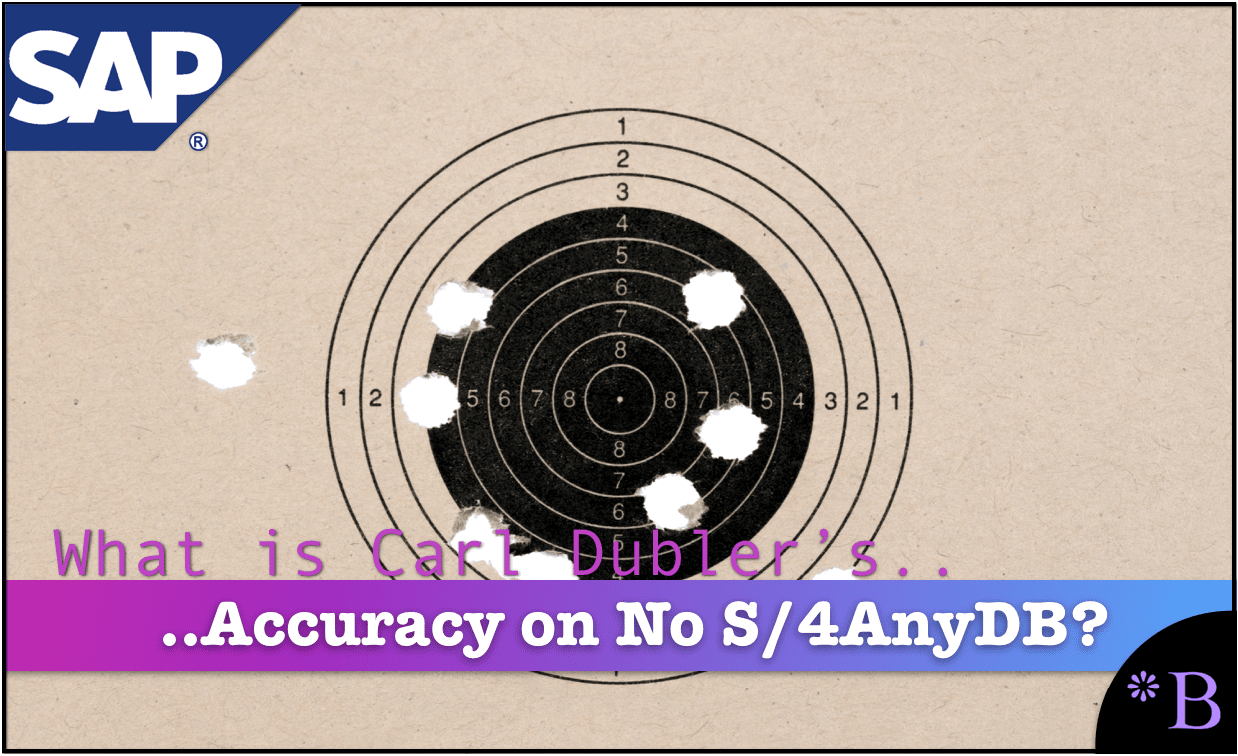How Accurate Was Carl Dubler on Why There is No S/4AnyDB?
Executive Summary
- Carl Dubler made bold predictions on HANA.
- We review how accurate he was in his article on a Why There Isn’t a “S/4AnyDB.”

Video Introduction: How Accurate Was Carl Dubler on Why There is No S/4AnyDB?
Text Introduction (Skip if You Watched the Video)
John Appleby’s article on the SAP HANA blog was titled Why There Isn’t a “S/4AnyDB” and was published on Oct 11, 2017. Carl Dubler, of SAP, provided an explanation of why SAP does not offer S/4HANA certification for non SAP databases. Carl makes it appear as if there are technological restrictions to using S/4HANA with non-SAP databases and that restricting S/4HANA to HANA is good for SAP customers. You will learn how accurate are Carl Dubler’s assertions.
Our References for This Article
If you want to see our references for this article and other related Brightwork articles, see this link.
Notice of Lack of Financial Bias: We have no financial ties to SAP or any other entity mentioned in this article.
The Quotations
HANA Is Not Getting All of the Growth it Deserves?
S/4HANA momentum continues with 4 major releases and over 1,000 live customers. Still, one of the top questions I get is, “Why doesn’t S/4HANA run on Oracle (or any other database besides HANA)?” This is a natural question, especially since SAP partnered with database vendors for our products prior to S/4HANA. Sometimes there is even speculation of an “S/4Oracle.” It’s not going to happen. Continue reading to learn what makes S/4HANA unique, and why ERP running on legacy database systems are now obsolete with S/4HANA and S/4HANA Cloud.
This is false. In 2019, roughly 1.5 years after this article, our research indicates that close to no customers live on S/4HANA, even though the SAP count is 2,000 customers. We covered the falsified S/4HANA customers in the S/4HANA Implementation Study. We predict that there will eventually be an S/4Oracle, as we covered in the article Why SAP Will Have to Backtrack on S/4HANA on HANA.
None of the previous databases like Oracle or DB2 is legacy, particularly with respect or in comparison with HANA as we covered in How Accurate is the SAP in Calling Non-HANA DBs Legacy?

Carl Dubler receives a Golden Pinocchio Award for his assertion regarding non-HANA databases being legacy. Ordinarily, we state that Golden Pinocchio Award winners lie, but with Carl Dubler, it’s unclear whether he knows what he is saying.
Why HANA?
Several years ago, SAP introduced the motto “Run Simple.” This is a nice sentiment, but how do we make it real? We start with the data model used to run ERP. The data model had to be simplified—this is the foundation of every innovation since.
The data model for S/4HANA is not simplified, as we covered in the article How Much Has HANA Really Been Simplified?
Some concrete examples:
Inventory Management went from 26 tables in ECC 6 on legacy database to 1 table on HANA.
In Finance, the Universal Journal (1 table) eliminates the painful process of FI-CO reconciliation (many tables).
A database’s complexity is far more than merely how many tables it has, as we covered in Does S/4HANA Have a Simplified Data Model? Each of the tables in HANA is more complex than the row-oriented tables.
Financial reconciliation is not due to many tables and is not a feature of the software. The complexity in reconciliation is due to the manual work in judgments, such as what revenue to recognized and when.

Carl Dubler receives a second Golden Pinocchio Award for his assertion regarding the reconciliation benefits of S/3HANA.
Extended Warehouse Management is back in core ERP and no longer needs its own system since the complex model required by legacy databases is gone. The same is true for Transportation Management, Advanced Available to Promise, and Advanced Variant Configuration, among others.
EWM is a dead product. Transportation Management is live at very few locations, so any improvements in these applications have minimal relevance. None of these applications ever required a complex model and none of the databases used by SAP before HANA can be classified as a legacy.
These aren’t dreams—these are innovations and productivity gains our customers are getting now. Imagine liberating your finance department from unproductive spreadsheet rodeos like reconciliation. Imagine providing your colleagues in supply chain MRP runs whenever they want, not just once per day. You can do this all while simplifying the IT landscape. With a simpler data model, your IT department is ready for anything, and your business is equipped with new, real-time capabilities.
HANA has multiple performance problems with MRP, as we covered in How to Interpret MRP Performance Problems with HANA.
For those interested in running MRP quickly, far more rapidly than anything possible in any SAP system, contact us about Real Time MRP.
These gains are simply not possible running on legacy database systems. We had to take the dramatic step of re-designing for an in-memory, columnar database. Obviously, we chose HANA for that. It isn’t good enough to take the 26 tables for Inventory Management and run them in-memory on, say, Oracle 12c. Simply running in-memory isn’t enough—we needed to leverage in-memory to redesign for a single data model. If you have a couple minutes, take a look at my video explanations here, here, and here. If you have more time, get a deep dive here.
Oracle In-Memory outperforms HANA, as does IBM DB2 BLU. Secondly, reconciliation is not an analytical workload. Therefore there is no reason to apply an in-memory database to this application.
This is also a recognition that with the move to a pure in-memory architecture, the two layers of database and application are merging. In the past, we depended on a separate database layer to organize data for transactions and analytics. Now the application can access the data with plenty of speed in-memory and not need to have it organized in advance. Trying to make this work with every database vendor’s different architecture would have limited the innovation and delayed the benefits for our customers.
The application layer and the database layer are not merging. SAP uses monopoly power in the application layer to extend its monopoly into Oracle’s monopoly in the database layer and DB2. SAP has it backward. HANA lags across the board in capabilities in its database versus Oracle and DB2 and is also far less stable than either database.
This is why we won’t have an “S/4AnyDB.” We can’t move our customers back into the complex data models of into the past. We partner with database vendors for ECC 6 which we continue to support until 2025. This explains why you might see agreements with them: it’s to support the past, not enable the future.
If there is no S/4AnyDB, the only reason is that SAP plans to push out vendors to capture database market share. There is no technical reason AnyDB cannot support S/4HANA and support it better than HANA.
Is It Working?
The real-world results are proving this was the correct strategy. The impact of a simpler data model is amazing. Business processes are transformed everywhere (see illustrations here). The best proof, however, is in the unprecedented adoption numbers for S/4HANA, the fastest-growing product in SAP’s 4-decade history. In a bit over 2 years, more than 6,300 customers have purchased it, and over 1,000 of them are already live (check out their stories). The transformation from traditional DB to the new HANA architecture has not been a limiting factor.
In 2019, 1.5 years after this article was published, there are almost no real S/4HANA implementations, and S/4HANA is one of the least successful of SAP’s upgrades to its widely used ERP system. Even in 2019, SAP only estimates 2,000 “live” customers, the close to other 7000 customers do not have S/4HANA even estimated as live. The reason for this is that S/4HANA is still an immature application.

Carl Dubler receives a Golden Parrot Award for repeating false information around S/4HANA. It seems that Carl can be made to repeat anything that SAP tells him to say.
Further Comment from Dubler
“IDC and ASUG both have surveyed and found about 2/3 of SAP customers plan to go to S4 starting 2018. There’s data in the ASUG survey about plans for on prem vs cloud, etc”
Unmentioned by Dubler is that neither IDC nor ASUG has any independence from SAP. ASUG is simply a marketing arm of SAP at this point, as we cover in How ASUG Lost its Way and Sold Out to SAP.
IDC was purchased by a Chinese construction firm and counted SAP as a customer, as we covered in Can You Trust IDC and Their Now China Based Owners?
Comment by Tim Main of IBM
“Whilst also understanding IBM has had sample S/4 Simple Finance code successfully running over Db2 BLU for in excess of 24 months now, I personally believe the SAP strategy to only offer S/4 over SAP HANA (now 2.0 vs 1.0 before) at release 1709 vs prior releases of 1510, 1611 etc is largely a marketing choice that seeks to force a top to bottom SAP stack over a Linux platform (either Intel or indeed HANA on Power).”
Tim is quite right.
SAP uses HANA to displace other database vendors, and the technical reasoning for customers having to use HANA is a way of SAP removing choice from SAP customers. Dubler responded to Tim Main, but his response was content-free, so there is nothing to discuss or even analyze in Dubler’s comment.
Response from Carl Dubler
“It is natural to ask tough questions of an enterprise product before buying it. That is why we offer several free, personalized tools to help customers understand what S/4HANA will mean for them, including Business Scenario Recommendations and S/4HANA Readiness Check. S/4HANA momentum is very strong (as the numbers in the article indicate) across all customer types, so I hope the client you heard from will take another look. S/4HANA also comes with a complete choice, including SaaS, private cloud, on premise, and IaaS (AWS, Azure, Google Cloud) so they can balance their needs for customization/control with accelerated deployment.”
Carl can’t discuss beyond being a sales parrot, so he needs to try to get out of the discussion, which is what he does here.
Conclusion
This article receives a 0 out of 10 for accuracy. The entire article is false from beginning to end, and Carl Dubler appears to be a mindless parrot who repeats what he is told to say.